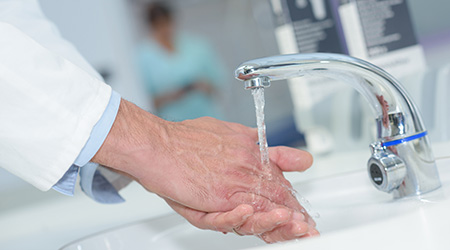Healthcare providers might need to clean their hands as often as 100 times per 12-hour shift, according to the Centers for Disease Control and Prevention (CDC). Why do we use hot water for hand washing? What is the science informing this standard? What are the implications of the gallons of hot water flowing to accommodate 100 hand washes multiplied by hundreds of clinicians? What does the most up-to-date science suggest?
Over the last several years, experts in infection control have been uprooting old assumptions that hot water is an essential component in hand washing.
“Apart from the issue of skin tolerance and level of comfort, water temperature does not appear to be a critical factor for microbial removal from hands being washed,” according to the World Health Organization. The CDC published guidance says, “The temperature of the water does not appear to affect microbe removal; however, warmer water may cause more skin irritation and is more environmentally costly. Water in the temperature range we can tolerate is not hot enough to kill bacteria. Water would have to be scalding hot before its temperature could improve upon the simple act of scrubbing with soap.”
More recently, domestic hot water systems in hospitals have been identified as breeding grounds for pathogens — including Giardia, Cryptosporidium, and Legionella — that pose a health risk to users. Legionella exposure can lead to infection and Legionellosis, a potentially fatal illness.
Legionella is naturally present in water systems, and it is usually not a public health problem — unless the water is warm enough to support amplification and maturation of the bacteria. By not heating the water to the range where Legionella thrives, the system behaves much like the cold-water system in that Legionella bacteria remain largely dormant.
In assessing the situation, managers need to consider: current dual-pipe systems with cold and hot water; the amount of fuel, piping, pipe hangers, insulation, mixing valves, maintenance issues; and the energy cost and energy-related carbon emissions. All of these factors, compared with the perceived benefits of warm water for hand washing, clearly would indicate the need for a more effective and inexpensive solution.
Mazzetti has been exploring and has implemented a single-pipe system for hand washing in one California outpatient clinic. Alleviating the need to accommodate cold and hot water, only tempered water at 70-75 degrees creates this opportunity. Managers need to consider the cost savings of a single-pipe system related to materials and installation, as well as the energy savings, infection prevention benefits and associated cost savings, and the dermatological comfort.
Today, we’re experiencing varying levels of code support and lack thereof:
- The Uniform Plumbing Code essentially allows for AHJs to dictate the appropriate use.
- International Plumbing Code essentially requires hot water for “washing.” Most AHJs would assert this requirement applies to hand washing.
- The Office of Statewide Health Planning and Development essentially requires hot water for “clinical” uses, which can be somewhat ambiguous.
- The Facility Guidelines Institute (FGI) essentially permits a single-temperature pipe system, but not all states recognize FGI as a guideline.
Evidence collection is in progress to be able to quantify the impact of a single-temperature system at 70-75 degrees for hand washing.
As science and technology evolve, so must codes, particularly in the business of designing healthcare facilities. We have great opportunities and perhaps an obligation to design less wasteful, less costly, and safer facilities to deliver patient care. Researching, piloting and advocating for code changes is critical to this improvement.
Brian Hageman is chief plumbing designer and associate principal with Mazzetti. He has more than 25 years of experience designing healthcare facility medical gas systems and waste and water systems. He has a keen focus on infection control issues, risk management, conservation of energy and water, and systems sustainability.

 Building Sustainable Healthcare for an Aging Population
Building Sustainable Healthcare for an Aging Population Froedtert ThedaCare Announces Opening of ThedaCare Medical Center-Oshkosh
Froedtert ThedaCare Announces Opening of ThedaCare Medical Center-Oshkosh Touchmark Acquires The Hacienda at Georgetown Senior Living Facility
Touchmark Acquires The Hacienda at Georgetown Senior Living Facility Contaminants Under Foot: A Closer Look at Patient Room Floors
Contaminants Under Foot: A Closer Look at Patient Room Floors Power Outages Largely Driven by Extreme Weather Events
Power Outages Largely Driven by Extreme Weather Events